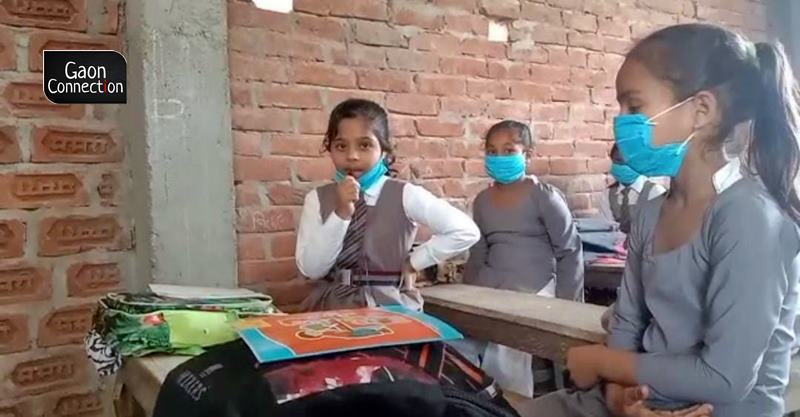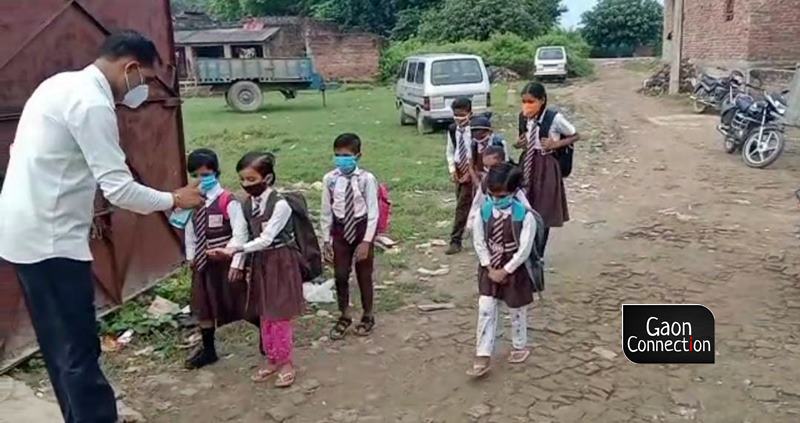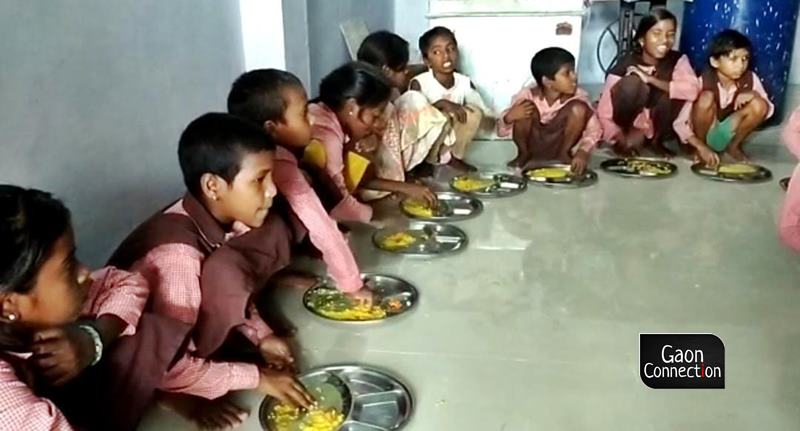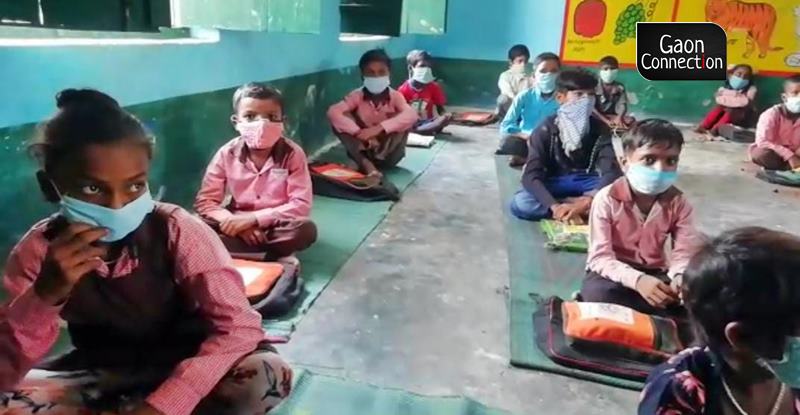Primary schools reopen in Uttar Pradesh after 18 months; excited teachers, notebooks and midday meal welcome the children
Been out of school for almost 18 months due to the exigencies arising out of the COVID19 pandemic, primary school children in Uttar Pradesh have returned to their classrooms and repatriated with their friends. Here’s what the students, teachers and parents had to say about the schools reopening.

A student of class third at Hind Montessori School in Barabanki, Amina Khan was visibly relieved as she sat with her friends in her classroom. Masked and dressed in a spotlessly clean uniform, Amina attended her classes in the school today, September 1 when primary schools reopened in Uttar Pradesh for offline classes, after a long wait of almost 17 months. Amina’s school had been shut ever since the central government announced the first lockdown during the first wave of the COVID19 pandemic on March 23, last year.
“Ghar me baithe bore hote the… kabhi mummy ki daant, kabhi papa ki daant. Kareeb do saal baad school khula hai, aaj humko bahot achha lag raha hai, hum bahot khush hain, teachers bhi bahot khush hain, aaj se achhe se padhayi karenge aur achhe marks laayenge,” the eight-year-old told Gaon Connection. (I used to get bored at home, used to get scolded by my mother or father every now and then. I am happy today, I’ll study well now and try to score good marks)
Somewhat similar was the excitement of 11-year-old Vishal from Mirzapur’s Madan Mohan Malviya Junior Highschool in Fathan area who told Gaon Connection that he was missing his friends dearly and wanted to meet them for more than a year.
Also Read: In the absence of mid-day meals, children in Bihar survive on roti-onion, bhaat-achar

“At school, we used to play, have fun, eat fruits and drink milk together (before COVID19 pandemic). I used to miss all this when the school was shut. Not being able to come here was getting very difficult. Ab bahot achha lag raha hai (Now I am feeling good),” he told Gaon Connection, with a mask covering his mouth and nose.
When asked about whether he studied at home during the lockdown, the class five student remained quiet.
Educational institutes across India have been shut for over a year now due to the COVID19 pandemic which has greatly impacted the learning and growth of children. A large number of reports by national and international organisations, including UNICEF, have pointed out how several children, especially from the economically weaker sections of the society, have fallen out of the education system.
Also Read: Education on hold: Amid the COVID lockdown, children in rural India will suffer the most
As the coronavirus cases have come down in several states, a number of states have started to reopen the schools for offline classes. Primary schools across Uttar Pradesh were reopened today on September 1 with clear instructions of following COVID protocols and other safety precautions. Schools also reopened in Delhi today.

Freshly cooked mid-day meal after a 1.5 years
The reopening of schools is not merely about the education for the rural children but it involves meeting the nutritional needs of the growing kids. The Indian government runs a large ‘mid-day meal’ scheme under which students in government schools receive one hot cooked meal at the school. However, due to the pandemic, the midday meal scheme was hanging in the air; while some states were providing dry ration in lieu of the cooked meal, others were offering money.
Also Read: Severely malnourished under-5 children consumed by hunger in the pandemic
At Unnao’s Shivpur village, the principal of the government primary school told Gaon Connection that — “After more than a year, we are witnessing food being prepared by the cook in the school. Apart from education, the mid-day meal program is a great attraction for the children,” Rajkishor Verma, principal of the government primary school at Unnao’s Shivpur village, told Gaon Connection. A total of 43 children are registered in this school but 24 of them attended it today.

“This (mid-day meal) is the only chance for the kids from poor and underprivileged families to eat a nutritious meal in a day. Unfortunately, that got disrupted due to Corona, I only wonder what difficulties these children must have faced during the time the school was shut,” the principal added.
“We are following all the COVID guidelines in the classrooms. New books have also arrived at the block office and will soon be distributed amongst the children once they are dispatched to the school,” Verma, the principal, added.
Meanwhile, Prabhas Kunwar Srivastava, block education officer at Sitapur’s Pisawan tehsil told Gaon Connection that he is constantly inspecting the schools and checking for any disregard for COVID-appropriate behaviour.
“If any school administration is found to be careless about the precautionary measures, strict action will be taken against it,” Srivastava said.

Gaon Connection spoke to some parents who accompanied their children to the school in the morning.
Govardhan Kumar (48), one such parent in Unnao’s Shivpur said, “Enough time has already been wasted due to mahamaari (pandemic). All the adults in our family have been vaccinated against COVID and I think it’s high time these kids should get back to their schools”.
“I am happy about the government’s decision to reopen the schools now,” he added.
Need to make up for the lost time
According to a report published by United Nations Children Emergency Fund (UNICEF) titled ‘COVID-19 and School Closures: One year of education disruption’, which was published in March 2021, merely 8.5 per cent school students in India have internet access and the disruption of education in the country due to COVID19 is second worst in South Asia — second only to Afghanistan.
Also, according to a survey conducted by Right to Education Forum in collaboration with the Centre for Budget and Policy Studies and United Nations Educational, Scientific and Cultural Organization (UNESCO), boys were being given priority over girls in online studies due to lack of computers or adequate number of mobile phones at home.
Neeraj Kumar Dubey, a teacher at the primary school in Shahjahanpur’s Pipri area agreed with these findings.
“We have tried to compensate for the loss of education by launching programmes on television and organising online classes but almost every student who comes to this school is from an underprivileged household and cannot afford these gadgets. Also, there is no substitute for learning in a physical classroom,” Dubey told Gaon Connection.

“We have found that the lessons that these children had learnt more than a year back are all forgotten. We will have to organise remedial classes for them to ensure that their learning is back on track,” Dubey added.
“Online padhayi ho rahi thi lekin kuch samajh me nahin aata tha usme,” an eight-year-old Ajit Kumar, a student from a primary school in Unnao told Gaon Connection. (Online classes were being organised but I barely understood anything)
Written by Pratyaksh Srivastava. With inputs from Sumit Yadav in Unnao, Virendra Singh in Barabanki, Brijendra Dubey in Mirzapur, Mohit Shukla in Sitapur, and Ramji Mishra in Shahjahanpur.

